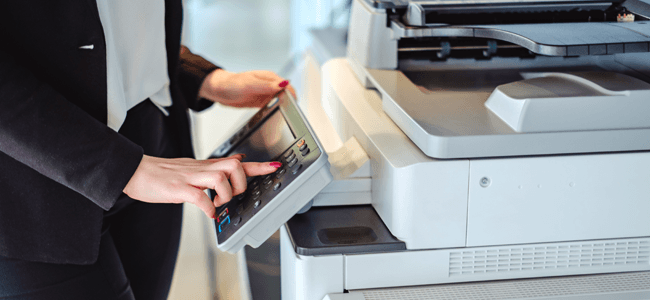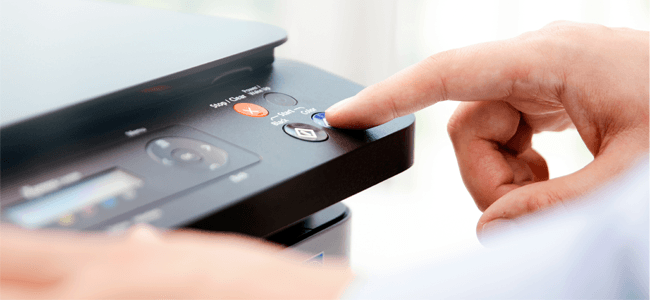
PRINTERS | 4 MIN READ
When you're shopping for a new printer, whether it's for your office or your house, you will typically come across two types of printers: laser and inkjet. As a metro-Atlanta based copier/printer dealer, we aim to use our industry expertise to educate our audience so they can make decisions that best benefit their business. Keep reading to learn the differences between the two and other helpful advice.
[Quick Summary] The main differences between a laser and inkjet printer are that an inkjet printer uses ink to print documents and is best suited for those who value high-quality prints, while a laser printer uses a laser and is best suited for those who value high-quantity printing. However, additional differences exist that we will cover in this article.
Not enough time? Jump to:
What's the Difference Between Toner and Ink Cartridges?
Should I Purchase a Printer from a Major Retailer or Local Dealer?
What's a Laser Printer?
Laser printers work by aiming laser beams at a rotating light-sensitive drum/photoreceptor to flash the image of the page, charges the areas of the drum that correspond to where areas of black and white or color appear in the image. By creating a negative charge in certain areas, the laser beam can print patterns such as text and pictures onto the photoreceptor.
The pattern on the drum is then coated with positively-charged toner that clings to areas negatively charged by the laser. When the paper goes through the printer, the toner is transferred through electric charge onto the paper, where it sticks, is melted on, and forms a clean finished image.
What's an Inkjet Printer?
An inkjet printer is a popular choice for home printing needs. They create images by precisely spraying thousands of tiny ink droplets onto paper, similar to how TV and computer screens render images through clusters of thousands of pixels.
Ink cartridges are usually sold in yellow, magenta, and cyan colors. Together, these three primary colors can be mixed by the printer to form whatever colors are necessary for the print job.
As paper is fed through a set of rollers, a piece called the print head moves back and forth, precisely spraying the ink. Though this technique is much simpler than laser printers, it can more easily lead to smudging.
RELATED: The Advantages and Disadvantages of Inkjet and Laser Printers
What's the Difference?

The main difference between the two is that an inkjet printer uses ink to print documents, while a laser printer uses a laser.
However, additional minute differences between the two exist that can lead to discrepancies in speed, image quality, and functionality. Based on your needs, you may favor one type of printer over the other.
Laser printers are best suited for those who:
- Print high volumes of black and white documents
- Need fast printers with large print capacity
- Do not need gallery-quality photo prints
- Need a printer for an office− Laser printers tend to be large and heavy, which makes them less suited for home offices
- Don't mind that toner cartridges tend to be more expensive than ink cartridges for inkjet printers− However, keep in mind that while they're more expensive up-front, they last much longer than ink cartridges
Inkjet printers are best suited for those who:
- Require high-quality images− Inkjet printers have better tonal variety and are better at blending colors
- Print on a wide variety of paper types− Laser printers cannot print on paper that's heat-sensitive, which limits the types you can use
- Don't print that often− These printers tend to be slower and their paper trays may not hold as much
RELATED: What is the Best Home Office Printer? [2021]
What's the Difference Between Toner and Ink Cartridges?
Toner cartridges are a powdery substance used in laser printers, while ink cartridges are a liquid substance used in inkjet printers.
Ink cartridges tend to be much more expensive in the long run since they must be carefully created for high-quality printing capabilities. Additionally, since they're in liquid form, the price to ship and store them are much greater than for toner cartridges.
While toner cartridges are more expensive up-front, since they come in a powder form, they store better over the long term, which means that the up-front investment may be more worthwhile for certain companies as opposed to ink cartridges, which tend to dry out over time.
Should I Purchase a Printer from a Major Retailer or Local Dealer?

When finding the right model for your needs, you may be stuck on whether to purchase your printer through a major retailer such as Staples or through a local dealer. Keep reading for an in-depth comparison.
Convenience
Many turn to major retailers for their perceived convenience. Similar to how quick it is to buy all that you need at a one-stop store like Target, being able to walk into a familiar store like Staples or order a printer on their website seems so easy.
However, although you may not be as familiar with a local dealer as you are with major retailers, the process of selecting and ordering a printer can be just as convenient with either type of seller. Usually, you can visit a major retailer and a local dealer's building to test different models in-person.
Additionally, as more people turn to online shopping, the process for purchasing a printer online has become just as simple as ordering a new pair of shoes from an online store, no matter if you go through a major retailer or local dealer.
Service
The level of customer service you experience with a local dealer cannot be beat. In general, small local businesses have lean teams that can really afford to personalize your experience and consistently follow up to ensure that your needs are addressed.
When it comes to printer repair service, local dealers also come out ahead. If your printer breaks and needs repairs, a major retailer like Staples will usually have you ship it away for fixes, which means you could potentially be waiting upwards of a month. Along with being slow, this type of service can also be costly since you pay for a one-time job.
Local dealers build service pricing into your contract, which makes any repairs easier to budget for. Additionally, since your local dealer's shop is located nearby, they can usually send a technician to your location to fix your machine that same day.
Price
While a printer from a major retailer can be cheaper, the prices they charge for cartridges can be as much as five times more expensive than local dealers. Both major retailers and local dealers can negotiate with you for lower prices on machines, but local dealers can keep cartridge prices much lower.
Local dealers try to maintain margins through their service contracts, which is why they value keeping cartridge prices low in an effort to consistently have business with a customer. Major retailers know that a customer may only need a cartridge every few months, which is why they charge so much.
Additionally, when factoring price into the purchase of a printer, consider downtime costs. If your printer purchased from a major retailer breaks, you may be out of a printer for a month while you ship away your printer for repairs. The costs associated with this scenario can quickly add up, as opposed to a local dealer who can usually fix your printer that day.
If you don't print that often and business operations wouldn't be greatly hindered from printer downtime, a major retailer could make more economical sense if their machine prices are lower.
Depending on your needs, a laser or inkjet printer could be a better fit. Before purchasing or leasing a printer, consider some of the points mentioned above.
For more printer-related content, follow our blog!
Posted by Erica Kastner

Erica Kastner is a lead Marketing Specialist at Standard Office Systems as well as a University of Georgia graduate. She aims to use her passion for problem-solving to help businesses understand how to better leverage their network infrastructure.

